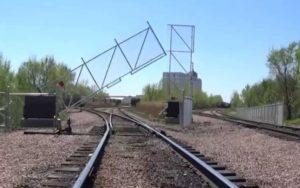Vertical Pivot Gates
Do you need the perfect solution in removing any gaps at the bottom of your gate? Do you not have enough storage space for a rolling, cantilever or swing gate? Your best choice may be a vertical pivot gate.
Vertical pivot gates are low weight gates that operate on a single pivot point that is located on one side of the opening. The gate pivots by lifting and vertically spinning on a single location at the base of the opening. To accomplish this opening and closing, the gate requires an operator. These operators are specific to the gate and designed to work in tandem. The operator uses a highly tensioned spring and hydraulic cylinder to open the gate. When in use, the spring pulls the gate back and up. The hydraulic cylinder controls the action. When closing, the cylinder and springs push up and forward, tensioning the spring.
Because vertical pivot gates virtually lift straight up, the gate frame can be designed to meet the terrain of the ground below the gate. This makes these gates very popular with installations that require no gaps such as airports and military bases. Vertical lift gates have also become very heavily used on railroad installations. Railroad tracks are placed on a thick base of rock. This creates a very convex and irregular surface through the gate opening. Vertical lift gates have been built to not only mirror the ballast but to work in and over the tracks, minimizing the gap.
Vertical pivot gates require ten feet of storage space along the gate opening. This is often less than half of the actual gate. This also makes vertical pivot gates very practical for downtown parking lots.
In areas of the country that receive a great deal of snow and ice, and are remote enough that the gates are not regularly maintained, vertical pivot gates have become very popular. On ranches and farms, these gates are an excellent choice when placed on solar power as these gates require little electrical installation with the hydraulic cylinder and offsetting spring gate operator installation. Vertical pivot gates do not slide or sweep, thus are not pushing snow or ice when opening or closing.
The downside to this type of gate installation is the considerable footing and concrete required to support the gate operator. This footing is the anchor for the system that presents a great deal of stability for gate. There is also a greater cost with a vertical pivot gate installation. The operator is very large and it components are much more significant than a standard slide gate operator and the gate is engineered and fabricated to work with the operator’s components.
